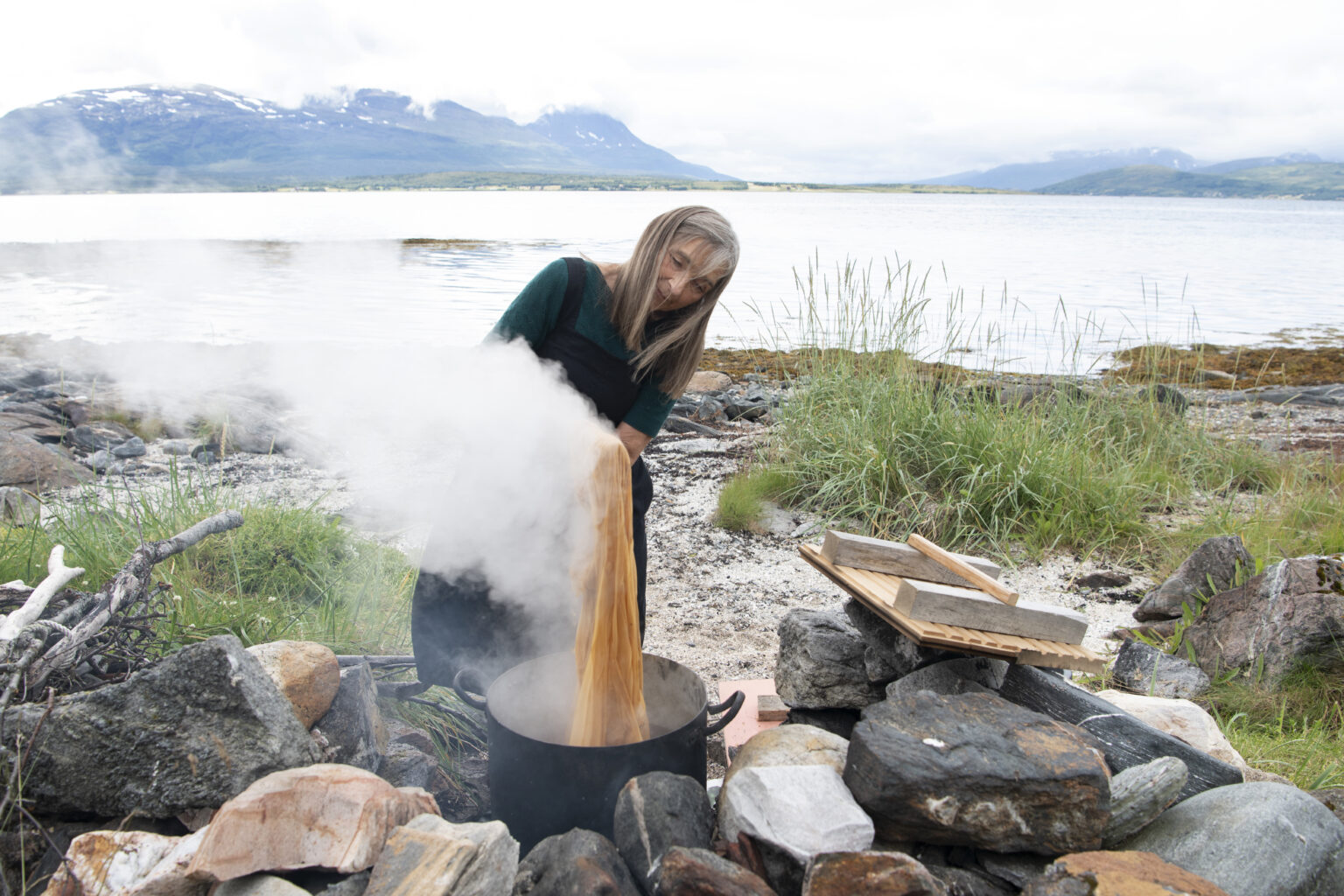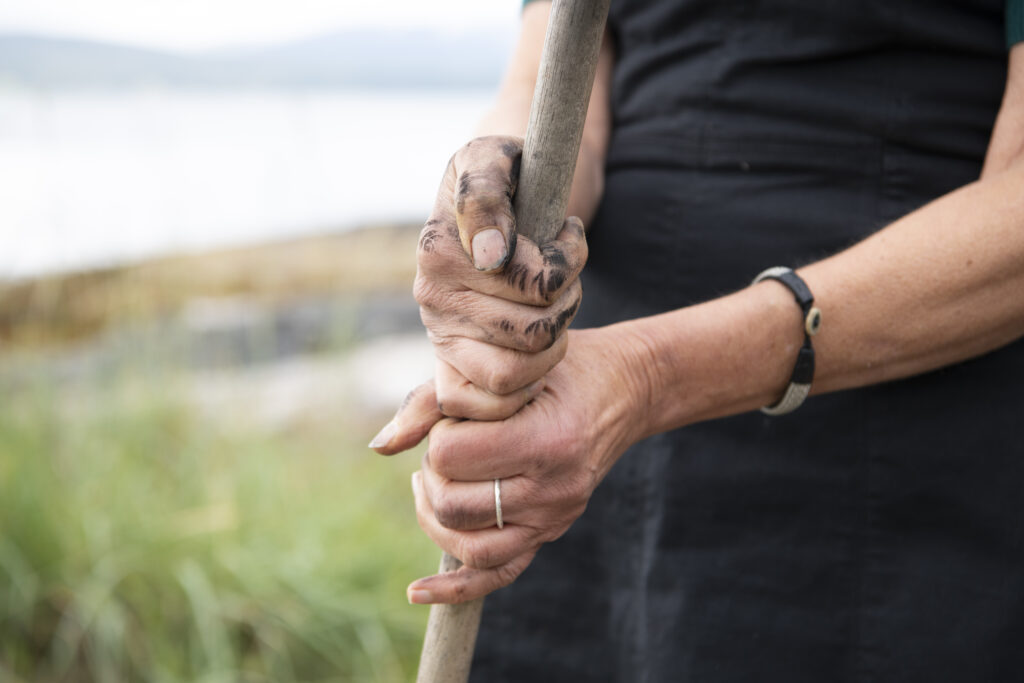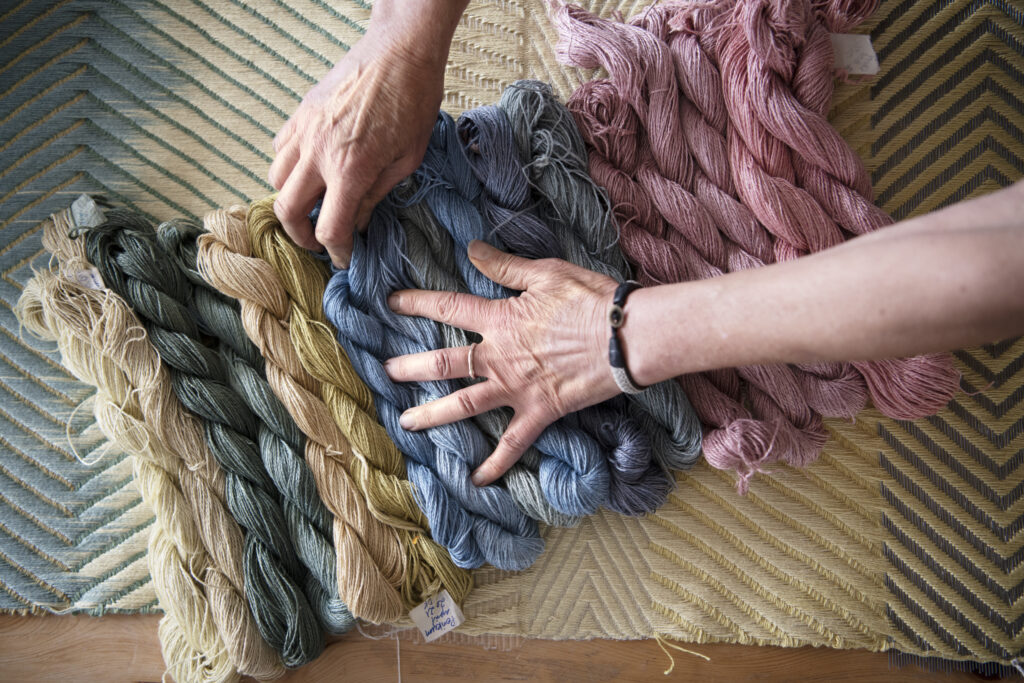A living part of the family structure
Ever since Hilde Hauan Johnsen was a child, traditional skills have been an important inspiration for her, both in her art and in her life in general.
“Plant dyeing, weaving, spinning, and other craft skills—this was all part of my childhood. I learned all these textile skills from my mother, my grandmothers, and my aunts. I am part of the generation that still had this as a living part of the family structure.”
But it was not only practical skills that she learned. The art of working together and collaborating —which would later become so important in her artistic practice—was also part of her upbringing.
“When it was time to weave floor mats, all the women in the family would gather to cut the cloth for the floor mat.[1] And we, the children, took part in it. It was the same with plant dyeing. My aunt really loved to plant dye, and I often joined her.”
One of Hauan Johnsen’s most important art projects is the collaborative The Stitch Project, which combines embroidery, plant dyeing, and spinning. In this ongoing project, she works together with five other artists: Kiyoshi Yamamoto, Maria Skeie, Margrete Kolstad Brekke, Britta Marakatt Labba, and Omaya Salman. They travel within Norway and internationally with a ten-metre linen cloth, which they invite people to embroider on while talking together. Since the start of the project in 2012, they have visited more than ten different countries and more than 40 events, from biennials, to festivals, exhibitions and galleries.
“Stitching is a universal act and an important part of culture all over the world. Everyone uses the stitch in one or another way,” Johnsen says.
Using the needle, the thread, and the tablecloth to bring people together is the most important part of the art project. But plant dyeing is also a central part of it.
“When we visit the different places, we look for plants and trees. What do we see the most of? What kind of leaves can we pick? Then we spin, embroider, and dye wool yarns or cloth with these different plants and make a portrait, in colour, of this place.”
Exploring borders
In 2021, Nordnorsk Kunstmuseum bought Hilde Hauan Johnsen’s plant dyed textile installation titled Fargeprisme fra NATUR 1: Norge/Russland & Palestina/Israel (2019) (Colour Prism of Nature 1: Norway/Russia & Palestine/Israel). It is part of a series she is still working on. This particular installation consists of approximately 30 silk fabrics, hanging alongside each other creating a tall six-by-four metre curtain of different colours. In total, 120 metres of silk is used in this massive installation. It speaks about materiality, process and knowledge passed through generations. The colours are from different plants gathered in Palestine and Israel, as well as by the border between Russia and Northern Norway. By harvesting, archiving, and using plants from these borders, Hauan Johnsen is investigating what the landscape can transfer to us in terms of knowledge.
“What I am curious about in this topic of borders is actually: if I go back in two or five years, will I find the same borders? Will the same plants be there? How are these borders (and the plant life) impacted by the political situation, or by climate change? I don’t think that everyone who sees this artwork will be curious about the same things as me. But for me, it is important that I will be able to go back later, and maybe find changes, and to bring back my experience from these places.”
A change in attitude
In recent years, we have seen a change in attitude towards traditional crafts. Working as a professor of textiles in Bergen between 2004 and 2018 (and now in Tromsø), Hauan Johnsen has experienced this renewed interest in textiles among her art students.
“When I came to the academy in Bergen in 2004, we could, within a few years, see a growing interest for the traditional crafts in textile. The students wanted to learn how to spin and how to weave, and they wanted to use these skills in their artistic practice. I experienced the same in Tromsø. When you have 18 out of 40 students wanting to be part of a workshop in embroidery with Britta Marakatt-Labba, or in large-scale fabric dyeing with Kiyoshi Yamamoto and me, or in weaving, that’s quite amazing in a small academy.”
Perhaps the most important shift in the textile arts that Hilde Hauan Johnsen has been a part of is the merging of the analogue with the digital. Through technological advances, the textile art field has incorporated new tools to explore and develop aesthetic qualities and expressions. Weaving, for example, has had a huge comeback in combination with digital technology.
“In Bergen, we got the first digital jacquard loom at the school’s weaving studio when I started as a professor in 2004. A lot of students became interested in this digital loom, where you sit and weave as if it is an old traditional loom, but you use the computer to feed the loom with the image or pattern you have prepared on a computer. It takes time to learn, and it’s interesting to see how engaged young artists are.”
Fibre optics
Since 2000, Hilde Hauan Johnsen has experimented with fibre optics in many of her artworks, often in combination with old techniques. One of her latest pieces, the installation from hearth of the house (Fra Arnestedet), which she made for Sparebanken Nord-Norge’s bank quarter in Tromsø, together with her son who programmed the light sources, is a great example of how a technological material may inform her artwork. In this particular piece, she also combined fibre optics with plant dyed materials for the first time in her practice.
She explains that the reason she chose to combine fibre optics with weaving and dyed yarns is that she wanted to bring together something old and something new, something high tech with something low tech.
“I dyed linen yarns with plants gathered around Tromsø. These were plants that I know have a history of being used in folk medicine, which is something I often use. I wanted to mix this old tradition with new technology that you would find in a bank. This building is packed with new technology. For example, there are fibre optics in broadband. And I use the same technology in my artwork. Except I do not send emails or things like that through it, I send light. When I made the artwork, I used fibre optics for the warp, and for the weft I used steel tread, glass bars, thin birch veneer. The outer layer was woven with the linen thread which was plant dyed, using plants that is also part of the folk medicine tradition in the North.”



